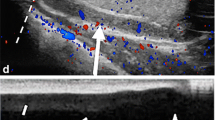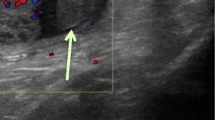Abstract
Imaging of the scrotum in the setting of acute symptoms such as pain or swelling is commonly performed emergently to differentiate between patients who require immediate surgery and those that do not. Acute scrotal symptoms are generally caused by infectious, traumatic or vascular etiologies. Rapid diagnosis and initiation of treatment is vital for testicular salvage in cases of acute testicular torsion, testicular rupture, and Fournier gangrene. Epididymitis, epididymo-orchitis, torsed testicular appendage, segmental testicular infarction, scrotal hematomas, testicular neoplasms, and acute idiopathic scrotal edema can have similar clinical presentations, but these conditions do not require immediate surgery. Ultrasound is the well-established first-line imaging modality for the acute scrotum. Contrast-enhanced ultrasound and magnetic resonance imaging can be useful as problem-solving tools when ultrasound studies are inconclusive or equivocal. This review describes normal scrotal anatomy and a wide range acute scrotal disorders, with emphasis on the imaging and clinical features that can minimize the risk of misdiagnosis.



















Similar content being viewed by others
References
Middleton WD, Middleton MA, Dierks M, Keetch D, Dierks S (1997) Sonographic prediction of viability in testicular torsion: preliminary observations. J Ultrasound Med 16:23-27.
Remer EM, Casalino DD, Arellano RS et al (2012) ACR Appropriateness Criteria ® acute onset of scrotal pain–without trauma, without antecedent mass. Ultrasound Q 28:47-51.
Wang CL, Aryal B, Oto A, et al (2019) ACR Appropriateness Criteria: Acute Onset of Scrotal Pain-Without Trauma, Without Antecedent Mass. J Am Coll Radiol, 16:5:S38-S43.
Sidhu P, Cantisani V, Dietrich C, et al (2018) The EFSUMB Guidelines and Recommendations for the Clinical Practice of Contrast-Enhanced Ultrasound (CEUS) in Non-Hepatic Applications: Update 2017 (Long Version). Ultraschall Med 39:e2-e44.
Dogra V, Bhatt S (2004) Acute painful scrotum. Radiol Clin North Am 42:349-363.
Dogra VS, Gottlieb RH, Oka M, Rubens DJ (2003) Sonography of the scrotum. Radiology 227:18-36.
Guideline developed in collaboration with the American College of Radiology; Society for Pediatric Radiology; Society of Radiologists in Ultrasound (2015) AIUM Practice Guideline for the Performance of Scrotal Ultrasound Examinations. J Ultrasound Med 34:1-5.
Baud C, Veyrac C, Couture C, Ferran JL (1998) Spiral twist of the spermatic cord: a reliable sign of testicular torsion. Pediatr Radiol 28:950-954.
Kühn AL, Scortegagna E, Nowitzki KM, Kim YH (2016) Ultrasonography of the scrotum in adults. Ultrasonography 35:180-197.
Berger RE, Alexander ER, Harnisch JP, et al (1979) Etiology, manifestations and therapy of acute epididymitis: prospective study of 50 cases. J Urol 121:750-754.
Horstman WG, Middleton WD, Melson GL (1991) Scrotal inflammatory disease: color Doppler US findings. Radiology 179:55-59.
Keener TS, Winter TC, Nghiem HV, Schmiedl UP (1997) Normal adult epididymis: evaluation with color Doppler US. Radiology 202:712-714.
Lavallee ME, Cash J (2005) Testicular torsion: evaluation and management. Curr Sports Med Rep 4:102-104.
Fehily SR, Trubiano JA, McLean C, et al (2015) Testicular loss following bacterial epididymo-orchitis: Case report and literature review. Can Urol Assoc J 9:E148-E151.
Green DB, Kawashima A, Menias CO, et al (2019) Complications of Intravesical BCG Immunotherapy for Bladder Cancer. Radiographics 39:80-94.
Lamm DL, van der Meijden PM, Morales A, et al (1992) Incidence and treatment of complications of bacillus Calmette-Guerin intravesical therapy in superficial bladder cancer. J Urol 147:596-600.
Demers V, Pelsser V (2012) “BCGitis”: A rare case of tuberculous epididymo-orchitis following intravesical Bacillus Calmette- Guérin therapy. J Radiol Case Rep 6:16-21.
Levenson RB, Singh AK, Novelline RA (2008) Fournier gangrene: role of imaging. Radiographics 28:519-528.
Yen Z, Wang HP, Ma HM, Chen SC, Chen WJ (2002) Ultrasonographic screening of clinically-suspected necrotizing fasciitis. Acad Emerg Med 9:1448-1451.
Zhao LC, Lautz TB, Meeks JJ, Maizels M (2011) Pediatric testicular torsion epidemiology using a national database: incidence, risk of orchiectomy and possible measures toward improving the quality of care. J Urol 186:2009-2013.
Lee FT Jr, Winter DB, Masden FA, et al (1996) Conventional color Doppler velocity sonography versus color Doppler energy sonography for the diagnosis of acute experimental torsion of the spermatic cord. AJR Am J Roentgenol 167:785-790.
Eaton SH, Cendron MA, Estrada CR, et al (2005) Intermittent testicular torsion: diagnostic features and management outcomes. J Urol 174:1532-1535.
Srinivasan A, Cinman N, Feber KM, Gitlin J, Palmer LS (2011) History and physical examination findings predictive of testicular torsion: an attempt to promote clinical diagnosis by house staff. J Pediatr Urol 7:470-474.
Frohlich LC, Paydar-Darian N, Cilento BG Jr, Lee LK (2017) Prospective Validation of Clinical Score for Males Presenting With an Acute Scrotum. Acad Emerg Med 24:1474-1482.
Baker LA, Sigman D, Mathews RI, Benson J, Docimo SG (2000) An analysis of clinical outcomes using color doppler testicular ultrasound for testicular torsion. Pediatrics 105:604-607.
Bentley DF, Ricchiuti DJ, Nasrallah PF, McMahon DR (2004) Spermatic cord torsion with preserved testis perfusion: initial anatomical observations. J Urol 172:2373-2376.
Cassar S, Bhatt S, Paltiel HJ, Dogra VS (2008) Role of spectral Doppler sonography in the evaluation of partial testicular torsion. J Ultrasound Med 27:1629-1638.
Dogra VS, Rubens DJ, Gottlieb RH, Bhatt S (2004) Torsion and beyond: new twists in spectral Doppler evaluation of the scrotum. J Ultrasound Med 23:1077-1085.
Munden MM, Williams JL, Zhang W, Crowe JE, Munden RF, Cisek LJ (2013) Intermittent testicular torsion in the pediatric patient: sonographic indicators of a difficult diagnosis. AJR Am J Roentgenol 201:912-918.
Kalfa N, Veyrac C, Baud C, Couture A, Averous M, Galifer RB (2004) Ultrasonography of the spermatic cord in children with testicular torsion: impact on the surgical strategy. J Urol 172:1692-1695.
Vijayaraghavan SB (2006) Sonographic differential diagnosis of acute scrotum: real-time whirlpool sign, a key sign of torsion. J Ultrasound Med 25:563-574.
Bayne CE, Villanueva J, Davis TD, Pohl HG, Rushton HG (2017) Factors Associated with Delayed Presentation and Misdiagnosis of Testicular Torsion: A Case-Control Study. J Pediatr 186:200-204.
Rafailidis V, Apostolou D, Charsoula A, Rafailidis D (2015) Sonography of the scrotum: from appendages to scrotolithiasis. J Ultrasound Med 34:507-518.
Sellars ME, Sidhu PS (2003) Ultrasound appearances of the testicular appendages: pictorial review. Eur Radiol 13:127-135.
Puri P, Boyd E (1976) Torsion of the appendix testis. A survey of 22 cases. Clin Pediatr (Phila) 15:949-950.
Baldisserotto M, de Souza JC, Pertence AP, Dora MD (2005) Color Doppler sonography of normal and torsed testicular appendages in children. AJR Am J Roentgenol 184:1287-1292.
Skoglund RW, McRoberts JW, Ragde H (1970) Torsion of testicular appendages: presentation of 43 new cases and a collective review. J Urol 104:598-600.
Ruiz Montes AM, Jimenez Alvarez C, Nunez Nunez R, Cabrera R, Blesa Sanchez E (1994) [The clinical characteristics of patients with torsion of the testicular and epididymal appendages]. Cir Pediatr 7:140-142.
Lev M, Ramon J, Mor Y, Jacobson JM, Soudack M (2015) Sonographic appearances of torsion of the appendix testis and appendix epididymis in children. J Clin Ultrasound 43:485-489.
Fernández-Pérez GC, Tardáguila FM, Velasco M, et al (2005) Radiologic findings of segmental testicular infarction. AJR Am J Roentgenol 184:1587-1593.
Bertolotto M, Derchi LE, Sidhu PS, et al (2011) Acute segmental testicular infarction at contrast-enhanced ultrasound: early features and changes during follow-up. AJR Am J Roentgenol 196:834-841.
Søreide K (2009) Epidemiology of major trauma. Br J Surg 96:697-698.
Bhatt S, Dogra VS (2008) Role of US in testicular and scrotal trauma. Radiographics 28:1617-1629.
Mulhall JP, Gabram SG, Jacobs LM (1995) Emergency management of blunt testicular trauma. Acad Emerg Med 2:639-643.
Morey AF, Brandes S, Dugi DD 3rd, et al; American Urological Association (2014) Urotrauma: AUA guideline. J Urol 192:327-335
Lupetin AR, King W 3rd, Rich PJ, Lederman RB (1983) The traumatized scrotum: ultrasound evaluation. Radiology 148:203-207.
Buckley JC, McAninch JW (2006) Use of ultrasonography for the diagnosis of testicular injuries in blunt scrotal trauma. J Urol 175:175-178.
Guichard G, El Ammari J, Del Coro C, et al (2008) Accuracy of ultrasonography in diagnosis of testicular rupture after blunt scrotal trauma. Urology 71:52-56.
Deurdulian C, Mittelstaedt CA, Chong WK, Fielding JR (2007) US of acute scrotal trauma: optimal technique, imaging findings, and management. Radiographics 27:357-369.
Bowen DK, Gonzalez CM (2014) Intratesticular hematoma after blunt scrotal trauma: a case series and algorithm-based approach to management. Cent European J Urol 67:427-429.
Lynch TH, Martínez-Piñeiro L, Plas E, et al; European Association of Urology (2005) EAU guidelines on urological trauma. Eur Urol 47:1-15
Morey AF, Metro MJ, Carney KJ, Miller KS, McAninch JW (2004) Consensus on genitourinary trauma: external genitalia. BJU Int 94:507-515.
Bleyer A, O’Leary M, Barr R, Ries LAG (eds) (2006) Cancer Epidemiology in Older Adolescents and Young Adults 15 to 29 Years of Age, Including SEER Incidence and Survival: 1975-2000. National Cancer Institute, NIH Pub. No. 06-5767. Bethesda, Maryland.
Mesquita RD, Rosas JL (2017) Adult Acute Scrotal Edema - When Radiologists Can Help to Avoid Unnecessary Surgical Treatment. J Radiol Case Rep 11:24-30.
Breen M, Murphy K, Chow J, Kiely E, O’Regan K (2013) Acute idiopathic scrotal edema. Case Rep Urol 2013:829345.
Santi M, Lava SAG, Simonetti GD, Bianchetti MG, Milani GP (2018) Acute idiopathic scrotal edema: Systematic literature review. Eur J Pediatr Surg 28:222-226.
Bueschen AJ (1990) Flank pain. In: Walker HK, Hall WD, Hurst JW (eds) Clinical methods: The history, physical, and laboratory examinations, 3rd edn, chap 182. Butterworths, Boston.
McGee SR (1993) Referred scrotal pain: case reports and review. J Gen Intern Med 8:694-701.
Author information
Authors and Affiliations
Corresponding author
Ethics declarations
Conflict of interest
The authors declare that they have no conflict of interest.
Additional information
Publisher's Note
Springer Nature remains neutral with regard to jurisdictional claims in published maps and institutional affiliations.
CME activity This article has been selected as the CME activity for the current month. Please visit https://ce.mayo.edu/node/99487 and follow the instructions to complete this CME activity.
Rights and permissions
About this article
Cite this article
Sweet, D.E., Feldman, M.K. & Remer, E.M. Imaging of the acute scrotum: keys to a rapid diagnosis of acute scrotal disorders. Abdom Radiol 45, 2063–2081 (2020). https://doi.org/10.1007/s00261-019-02333-4
Published:
Issue Date:
DOI: https://doi.org/10.1007/s00261-019-02333-4




